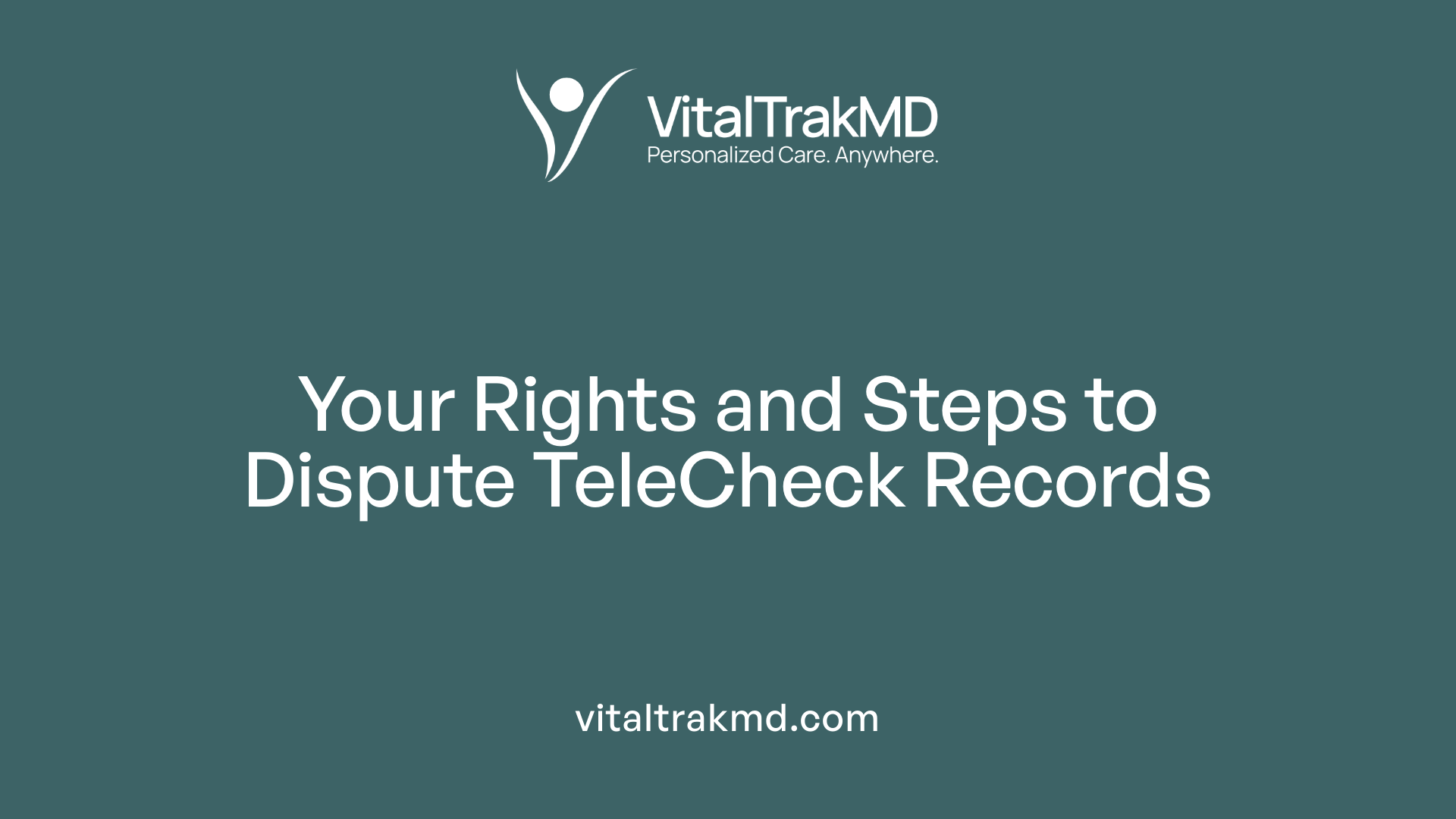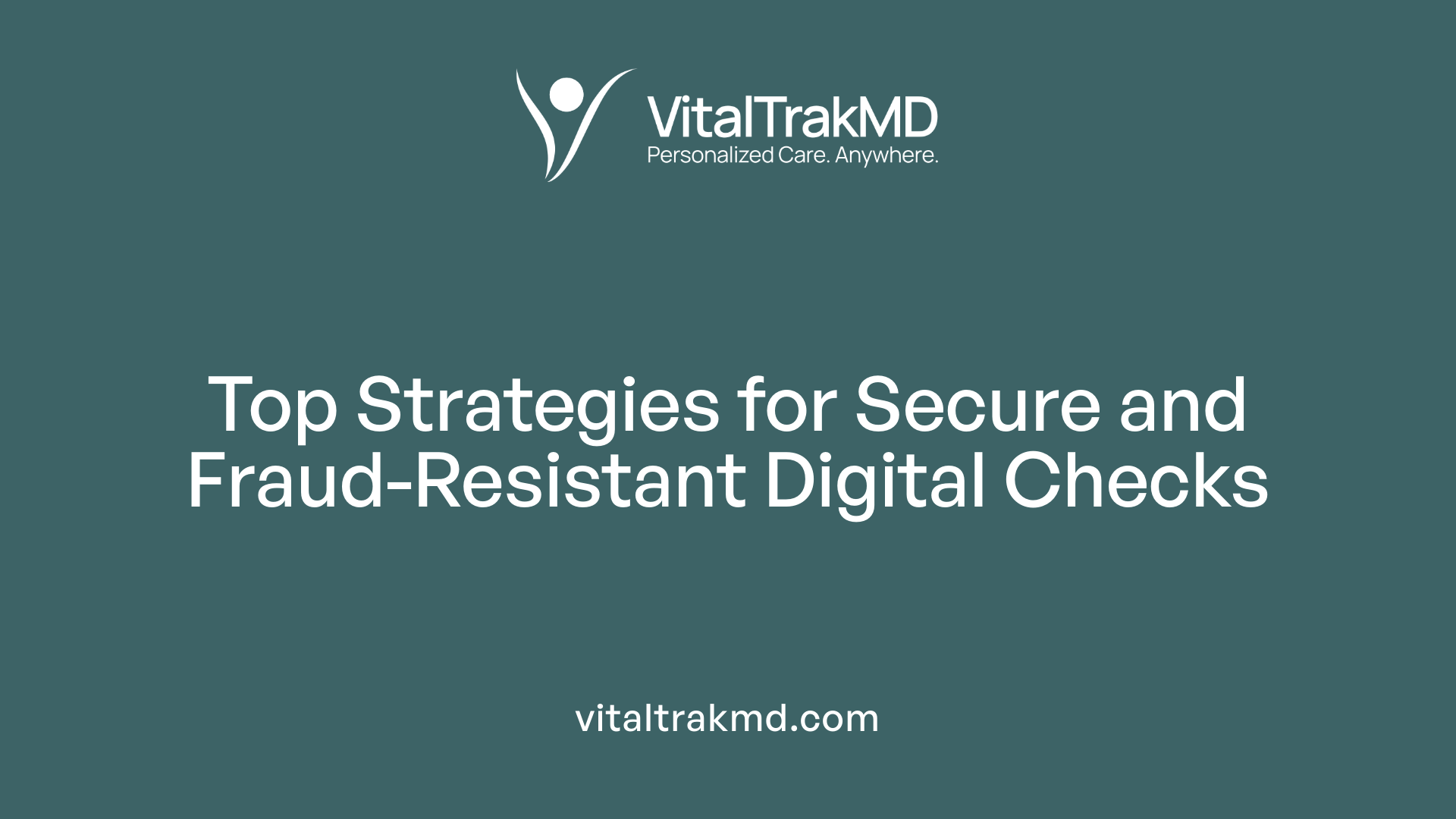Don’t Have Time for Follow-Up Visits? Try TeleCheck-ins

Transforming Follow-Up Care and Check Handling in the Digital Age
In today’s fast-paced world, healthcare providers and financial institutions are increasingly turning to innovative digital solutions to streamline processes, improve engagement, and enhance security. TeleCheck, a key player in check verification and risk assessment, exemplifies how data-driven tools and telehealth options like telecheck-ins can revolutionize traditional practices, offering convenience, safety, and efficiency. This article explores the role of TeleCheck in check approval, addresses handling declines and disputes, highlights consumer rights and legal considerations, and examines how telehealth innovations are addressing follow-up care challenges.
Understanding TeleCheck’s Role in Check Approval and Decline Reasons
What is TeleCheck’s function as a consumer reporting agency?
TeleCheck acts as a consumer reporting agency that specializes in collecting and analyzing data related to checks and bank accounts across the United States. Its primary role is to assist retailers and financial institutions in assessing the risk associated with accepting checks from consumers. By evaluating past check writing behavior, unpaid debts, and other transaction patterns, TeleCheck provides information that helps merchants decide whether to accept or decline a check.
How do TeleCheck’s codes and reasons for check declines work?
When a check transaction is submitted for approval, TeleCheck evaluates multiple risk variables. If the system determines that the check should not be accepted, it provides a decline code, which is a numerical or alphanumeric identifier explaining the reason for the rejection.
For example, Decline Code 3 indicates that the check cannot be approved and cannot be overturned, usually because the risk is considered too high based on TeleCheck’s assessment. These codes help merchants understand why a check was declined, although they do not specify whether insufficient funds are the cause.
What factors influence whether a check is accepted or declined?
Several elements influence the decision to accept or decline a check. Insufficient history in TeleCheck’s database, unpaid debts, and previous negative reports can raise the risk profile. Human errors or potential fraud also play a role. Additionally, if TeleCheck has limited information, it may default to declining a check rather than risking acceptance.
Other factors include the check type, as certain payments like payroll checks or international checks are not processed through TeleCheck’s system. Importantly, the evaluation does not consider the individual’s bank balance or credit score, but rather transaction history, patterns, and risk profiles.
How does real-time risk assessment work?
During the point-of-sale process, checks are analyzed instantly through TeleCheck’s system. The system uses identifying data—such as check number, amount, and transaction location—and compares it against hundreds of variables, including known fraud patterns, spending behaviors, and previous issues.
This real-time analysis helps generate a risk code that indicates whether a transaction is high or low risk. If flagged as high risk, the check may be declined, allowing merchants to make immediate informed decisions. This process helps prevent fraud and reduces the likelihood of accepting bad checks.
| Aspect | Description | Example/Details |
|---|---|---|
| Decline Codes | Numerical or alphanumeric codes | Code 3: Check cannot be approved |
| Influencing Factors | History, unpaid debts, risk variables | Risk of fraud, insufficient data |
| Risk Assessment | Instant analysis at sale | Flagging high-risk transactions |
| System Limitations | No access to bank balances | Based on reported data and patterns |
Understanding these aspects helps consumers and merchants grasp how TeleCheck facilitates responsible check processing while highlighting the importance of maintaining clear check writing habits.
Navigating TeleCheck Disputes and Consumer Rights
 Consumers who find inaccurate or outdated information on their TeleCheck report have the right to dispute these entries. If a negative item appears, such as a record of unpaid debts or refused checks, individuals can initiate a dispute to correct or remove false data.
Consumers who find inaccurate or outdated information on their TeleCheck report have the right to dispute these entries. If a negative item appears, such as a record of unpaid debts or refused checks, individuals can initiate a dispute to correct or remove false data.
Under the Fair Credit Reporting Act (FCRA), consumers are entitled to request a free copy of their TeleCheck report once every year. This report provides a detailed history of their check transaction records and can help identify errors or discrepancies.
To request a free annual report, consumers should contact TeleCheck directly through their designated channels, either online or by phone. Upon receiving the report, it’s important to carefully review all details, especially any entries that might impact future check acceptance.
If errors are found, consumers can follow a formal process to resolve inaccuracies. This involves submitting a dispute explaining the specific inaccuracies, supporting documentation if available, and requesting that TeleCheck investigate and correct the data.
TeleCheck is required by law to complete their investigations within 30 to 45 days. During this period, they will review the dispute, typically by re-evaluating the data or obtaining further information from data sources.
Consumers should keep records of all communications and evidence related to their dispute. If the investigation confirms errors, the negative entries will be corrected or removed from their report. If the dispute is unresolved or denied, individuals have the right to add a statement to their record explaining their perspective.
Understanding these rights and procedures ensures consumers can protect their reputation and improve the chances of future check acceptance. Regularly checking reports and promptly addressing inaccuracies are essential steps in managing financial health.
How to Contact TeleCheck for Support and Assistance
If you need help or want to speak directly with someone at TeleCheck, there are several support options available. You can call their dedicated customer support line at +1 800-835-3243. This line serves consumers, merchants, and financial institutions, providing assistance for a variety of issues related to check acceptance and credit reports.
For online support or specific report requests, visit TeleCheck’s support website at getassistance.telecheck.com. This platform offers resources for retrieving reports and resolving common issues.
Consumers are entitled to one free copy of their credit report each year. To request this copy by mail, send a written request to TeleCheck Services, Inc., Attention: Consumer Resolution Services, P.O. Box 6806, Hagerstown, MD 21741-6806. This process helps individuals review their data and verify any negative items.
Disputing negative entries on a TeleCheck report can be done through various methods. Consumers can contact TeleCheck Merchant Services at 1-800-366-1054 for account-related questions or submit disputes in writing. It’s important to provide detailed information and any supporting documentation. The Fair Credit Reporting Act (FCRA) mandates that TeleCheck investigates disputes within 30 to 45 days.
Additional contact options and resources are available through TeleCheck’s parent company, Fiserv, which helps streamline support and dispute processes. By utilizing these contacts and resources, consumers can resolve issues efficiently and protect their credit information.
What Does a Declined Check on TeleCheck Signify?

What does it mean when a check is declined on TeleCheck?
When a check is declined on TeleCheck, it indicates that the system perceives a potential risk associated with accepting the check. This assessment is based on TeleCheck’s risk evaluation models, which analyze various data points to determine whether the transaction could involve fraud or insufficient funds. It's important to understand that a decline does not automatically mean the account lacks funds.
System’s risk assessment logic
TeleCheck employs sophisticated algorithms that evaluate hundreds of variables, including previous check history, unpaid debts, and risk patterns typical of fraudulent activity. The system does not access current bank balances. Instead, it relies on its database and statistical models to assign a risk profile to each check.
Common reasons for decline
There are several reasons a check might be declined:
- Lack of sufficient history or data in TeleCheck’s database.
- Presence of unpaid debts or unresolved negative records.
- Previous suspicious activity associated with the individual.
- Human error during data entry.
- Victims of fraud or identity theft. Certain checks, like payroll checks or international checks, are also excluded from TeleCheck’s processing.
Difference between insufficient funds and risk flags
Importantly, a decline does not necessarily mean the customer has insufficient funds in their bank account. Instead, it often signals that TeleCheck’s data suggests a higher risk based on their models. For example, the check may be flagged for suspected fraud or because there’s limited information available in the system.
Consumers’ rights to dispute a decline
If a check is declined, consumers have the right to dispute the decision. They can request a copy of their TeleCheck report to review the data used in the risk assessment. Under federal law, consumers are entitled to a free report once a year. If inaccuracies are found, consumers can initiate a dispute process, which TeleCheck is required to investigate within 30 to 45 days.
Understanding the reasons behind a declined check on TeleCheck can help consumers address potential issues, improve future check approval chances, and exercise their rights to dispute inaccuracies.
Duration of TeleCheck Records and How They Affect You

How long does a bad check or TeleCheck record stay on my record?
A bad check or TeleCheck record typically stays on your banking report for five to seven years. This information can influence your ability to have checks accepted by retailers, as many establishments consult TeleCheck or similar systems before approving check payments.
TeleCheck maintains a detailed history of entries in its Review system, which can be searched by date, county, or even the hunter’s last name if related to game checking. New entries may take up to 24 hours to appear in the system, so monitoring your record regularly is recommended.
You can review individual entries to verify their accuracy. If you believe there is incorrect or outdated information, it’s important to contact TeleCheck directly at 1-800-858-1549. Addressing inaccuracies promptly helps ensure your record reflects your true payment history.
It's also worth noting that the system strictly prohibits entering false information. Regularly monitoring your TeleCheck record can help you catch and dispute errors early, maintaining a clearer financial profile for future transactions.
For additional details on how records are retained and disputes are handled, searching for terms like "Record retention and dispute resolution for TeleCheck records" can provide helpful guidance.
The Impact of AI and Telehealth on Follow-Up Processes

How AI is Changing Scheduling and Reminders
Artificial Intelligence (AI) is revolutionizing appointment management by automating scheduling and sending timely reminders. Healthcare organizations use AI-powered systems to schedule visits, send appointment alerts, and follow up with patients, reducing missed appointments.
These systems analyze patient data to personalize communication and ensure reminders are sent at optimal times, such as within 15 minutes of the scheduled appointment or shortly afterward if a patient no-shows.
Multi-Agent AI Systems for Better Coordination
Multi-agent AI systems involve multiple specialized AI agents working together to handle complex operations like verification, scheduling, and follow-up. For instance, one agent might verify patient eligibility, while another manages appointment reminders.
This collaboration improves accuracy and speeds up processes, reducing errors commonly seen with manual handling. Healthcare providers benefit from these efficient systems that coordinate care and enhance patient follow-up.
Integration with Electronic Health Records (EHR)
Implementing AI during EHR transitions consolidates various tools and enhances interoperability. AI can automatically update patient records with appointment history, test results, and follow-up notes, ensuring that healthcare providers have the latest information.
This integration helps streamline workflows, reduce vendor sprawl, and improve overall management of patient data, leading to better follow-up care.
Benefits of Telehealth: Convenience and Safety
Telehealth allows patients to consult with providers via video or phone, eliminating the need for physical visits. It offers significant advantages such as reducing the risk of illness transmission, saving time, and increasing access from home, work, or on the go.
Patients can track health data—like blood pressure or blood sugar levels—and share it with providers remotely. This convenience encourages regular follow-up, especially for chronic condition management.
Enhancing Patient Engagement and Compliance
Combining AI and telehealth enhances patient engagement by offering personalized communication and immediate access to care. Automated follow-ups, reminders, and easy access to providers motivate patients to stay compliant with treatment plans.
Research shows that prompt follow-up calls within 24 hours of a missed appointment significantly increase return rates, demonstrating how technological tools foster stronger patient-provider relationships.
| Technology Aspect | Benefit | Impact on Follow-Up | Example| |-------------------|---------|----------------------|---------| | AI Scheduling and Reminders | Automates appointment setup and alerts | Decreases no-shows | AI systems send reminders and reschedule calls | | Multi-Agent AI | Collaborates across tasks | Improves accuracy and speed | Coordinated verification and follow-up processes | | EHR Integration | Consolidates patient data | Facilitates seamless communication | Automatic updates of follow-up notes | | Telehealth | Remote consultations | Increases access and safety | Video visits for follow-up care | | Patient Engagement | Personalizes communication | Enhances compliance | Automated messages and immediate feedback |
These technological improvements collectively enable healthcare providers to follow up more effectively, engaging patients better and reducing missed appointments, ultimately leading to improved health outcomes.
Enhancing Check Security and Fraud Prevention in Digital Transactions

Best practices for safe check handling
Receiving and processing checks requires careful attention. Consumers should always sign checks with a consistent signature, keep checks in a secure location, and report lost or stolen checks immediately. Merchants must verify the signature, compare details with the customer, and keep records of transactions. Proper storage and prompt handling reduce the risk of theft or fraud.
Strategies to prevent check fraud
Preventing fraud begins with awareness. Consumers should avoid writing checks with missing or incorrect information and regularly review bank statements for unauthorized transactions. For merchants, implementing verification systems such as TeleCheck can flag high-risk transactions based on historical and behavioral data. Limiting check acceptance to trusted sources and using secure methods for check processing further reduces risks.
Cybersecurity tips for consumers and merchants
Online and electronic check handling should be secured with strong passwords, two-factor authentication, and encryption. Consumers should safeguard their banking information and report any suspicious activity immediately. Merchants must ensure their POS systems are updated, regularly monitored for breaches, and compliant with security standards, including PCI DSS. Educating staff and customers about phishing and scams also plays a vital role.
How risk profiling helps detect fraudulent activities
TeleCheck uses statistical models to analyze hundreds of variables—such as spending patterns, transaction types, and previous unpaid debts—to build risk profiles. High-risk scores can alert merchants to potential fraud, enabling them to take additional verification steps before accepting a check. This proactive approach helps catch fraudulent transactions early, reducing financial losses and protecting consumers.
| Strategy | Description | Benefits |
|---|---|---|
| Secure storage | Keep checks in safe locations | Prevent theft and misuse |
| Verification systems | Use risk models and databases | Detect risky transactions |
| Electronic security | Implement encryption and multi-factor authentication | Protect data from cyber threats |
| Regular monitoring | Review transactions and accounts | Identify anomalies early |
By adopting these practices, both consumers and merchants can create a more secure environment for check transactions, reducing the risk of fraud and enhancing overall transaction integrity.
The Future of Check Processing and Patient Engagement
As digital solutions like TeleCheck and telehealth continue to evolve, they are transforming the landscape of financial and healthcare services. Ensuring secure transactions, protecting consumer rights, and leveraging AI for operational enhancement will be central to delivering seamless, efficient, and safe experiences. Embracing these innovations not only improves convenience but also builds trust, helping consumers and providers meet today’s demands for speed, security, and personalized service.
References
Recent articles
Want to Feel Better and Live Healthier?
Join hundreds of patients taking control of their health with personalized care that fits their life – not the other way around.
Rated 4.8/5 by 32+ customers







